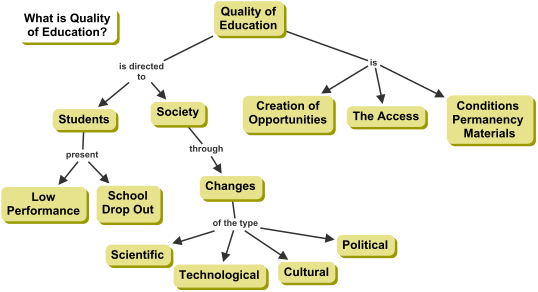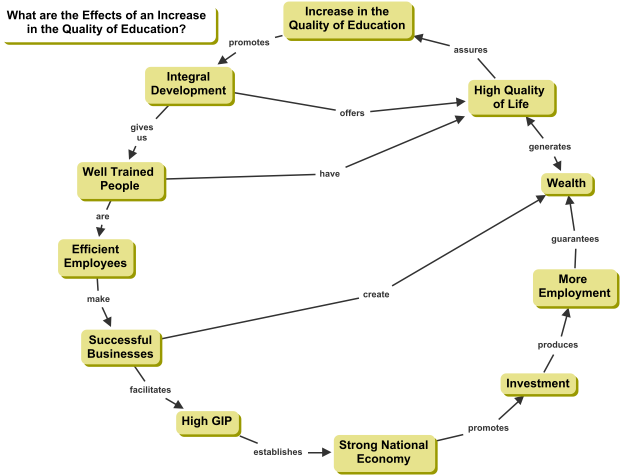Concept maps are graphical tools for organizing and representing knowledge that explicitly express a person or group of persons' understanding about a domain. A good way to delineate the context for a concept map is to define a Focus Question, that is a question that clearly specifies the problem or issue the concept map should help to resolve. Every concept map responds to a focus question, and a good focus question can lead to a much richer concept map, as will be examined below. When learning to construct concept maps, learners tend to deviate from the focus question and build a concept map that may be (somewhat) related to the domain, but which does not answer the question. This is fine in the sense that the map built probably answers another focus question, and so the focus question of the map should be changed to reflect this. (CmapTools provides a field for the focus question as part of the information that is stored with a Cmap, and the focus question is displayed in the header of the window when a map is displayed, making the focus question explicit to the viewer). In the case of a school-learning environment, it may be important to have the learner go back and construct a concept map that responds the original focus question.
Starting with a single focus question does not imply that the 'job is done' when that question is answered. Fagundes & Dutra (2006) emphasize in their work with teachers and students the importance of questioning each individual concept in a concept map (do I understand what this concept really means and its relationship with its linked concepts?) This leads to further research and searching, and to the generation of focus questions for other concept maps that may end up linked to the original map.
As a student is building a concept map, the teacher should probe the student to (a) find out how much the student knows about the topic and how his/her understanding evolves, and (b) help the student go deeper into understanding the subject and thereby improve, refine or expand the concept map. Unfortunately, there is little research on question-asking during concept map construction. Chacón (2006) has reported on the "pedagogical question" and its use as a mediating instrument during concept map construction. She refers to three moments during the construction of concept maps: (a) defining the context, where she proposes that questions be asked that help determine the context, such as "Why are we addressing this problem?", "Why use concept maps to solve this problem?", "Where do we find information?" among others; (b) development of the concept map, where the focus question is constructed, inquiry questions such as "where? what? who?" help establish what the student(s) already know, verification questions are used to verify whether propositions in the concept map are true or not and if they are coherent or not, and amplifying questions help find out if information is missing or concepts need to be expanded and crosslinks added; (c) awareness, where through questions the student can take cognizance over how he/she is building his/her Cmap both during map construction and when finishing the construction. Questions at this time are aimed at the metacognition, becoming aware of how the concepts and propositions are build, decision making has taken place, with students offering explanations: "I am describing...", "I am deducing...", "I am establishing a relation...", "I am applying...", "I am assuming..."
In companion documents we have discussed how concept maps focused on events tend to be richer in explanations whereas concept maps focused on objects tend to be more descriptive (What is a Concept? ... from a Concept Mapping Perspective, What are Linking Words? ... from a Concept Mapping Perspective), and examined the distinction between static and dynamic propositions (What is a Proposition? ... from a Concept Mapping Perspective). In general, concept maps showing explanations require more deep or dynamic thinking. We have observed, however, that most concept maps deal with objects, not with events, and propose that through the proper focus question, and through questioning in general, we could move towards the dynamic thinking that is required to build concept maps showing explanations.
In a series of studies, Safayeni, Derbentseva and Cañas (2005) have found that the structure of concept maps can be indicative of the level of thinking expressed in the map. For example, concept maps modeled with a circular structure (see Figures 1 and 2) lead to significantly more instances of meaningful or dynamic propositions when compared with concept maps modeled with a tree-like structure. In work presented at the Concept Mapping conferences (Derbentseva, Safayeni, & Cañas, 2004, 2006) they further report on experiments comparing two strategies to encourage the construction of more dynamic relationships: the use of quantifiers on the root concept of a concept map and a dynamic focus question. Interestingly, although a more dynamic focus question has an effect on the nature of the propositions generated, it is adding a “quantifier” to the root of the concept map that has the greatest impact. Although the results of the experiments are preliminary, they report on three methods by which more dynamic thinking can be encouraged: cyclic maps, a dynamic focus question and a quantified root concept.

Figure 1. Tree-structure concept map generated from a static focus question.
We have started applying these ideas in our work with concept mappers, and have found that although a more dynamic focus question can generate a more dynamic map, concept mappers often ignore the question’s nature and construct a declarative concept map. Adding a “quantifier” to the root concept, as reported above, tends to force the mapper to generate a more dynamic set of propositions. This is shown in two concept maps on the topic “Quality of Education” constructed by teachers during workshops, where the concept map in Figure 1 was constructed from the focus question “What is Quality of Education?” and was not given a root concept, resulting in a declarative type map, and Figure 2 was constructed from the Focus Question “What are the Effects of an Increase in the Quality of Education?” and a root concept of “Increase in Quality of Education” (an event), resulting in an interesting cyclic map based on dynamic propositions.
Lets not misinterpret our recommendation for more dynamic concept maps as implying that declarative concept maps are no good and should be avoided. There is room for both types of representations, both declarative and explanatory. A good descriptive map will definitely show understanding by the map builder. We are emphasizing the need to not stop there and move on to also elaborate maps that are more explanatory.

Figure 2. Cyclic concept map generated from a dynamic focus question and a quantified root concept.
| Static Focus Questions | Dynamic Focus Questions | ||
| What are the parts of a plant? | How do the different parts of the plant help to produce food for the plant? | ||
| What is the Ozone Hole? | What effects does the Ozone Hole have on health and global warming? | ||
| What is the Panama Canal? | How has the Panama Canal influenced Panama, economically and culturally? | ||
What is a compound interest rate? |
How can we take advantage of compound interest rates to save for retirement? |
The studies by Safayeni and colleagues serve to illustrate how much we have yet to learn about strategies for optimizing the use of concept maps for the encouragement of high levels of dynamic thinking and meaningful learning. Their work also serves to illustrate the importance of defining and using good focus questions. This has long been recognized, and it is one reason why CmapTools calls for the inclusion of a focus question whenever a concept map is saved. Unfortunately, we often see that concept mappers fail to define a focus question in advance of building a concept map, or they simply ignore the question as their map construction progresses.
Chacón, S. (2006). La Pregunta Pedagógica Instrumento de Mediación en la Elaboración de Mapas Conceptuales. In A. J. Cañas & J. D. Novak (Eds.), Concept Maps: Theory, Methodology, Technology. Proceedings of the Second International Conference on Concept Mapping. San José, Costa Rica: Universidad de Costa Rica.
Derbentseva, N., Safayeni, F., & Cañas, A. J. (2004). Experiments on the Effect of Map Structure and Concept Quantification during Concept Map Construction. In A. J. Cañas, J. D. Novak & F. M. González (Eds.), Concept Maps: Theory, Methodology, Technology, Proceedings of the First International Conference on Concept Mapping. Pamplona, Spain: Universidad Pública de Navarra.
Derbentseva, N., Safayeni, F., & Cañas, A. J. (2006). Two Strategies for Encouraging Functional Relationships in Concept Maps. In A. J. Cañas & J. D. Novak (Eds.), Concept Maps: Theory, Methodology, Technology. Proceedings of the Second International Conference on Concept Mapping. San Jose, Costa Rica: Universidad de Costa Rica.
Fagundes, L., & Dutra, I. (2006). Personal communication.
Safayeni, F., Derbentseva, N., & Cañas, A. J. (2005). A Theoretical Note on Concept Maps and the Need for Cyclic Concept Maps. Journal of Research in Science Teaching, 42(7), 741-766.
Additional References
This document borrows loosely from the following publications by the authors:
Cañas, Alberto J., & Novak, Joseph D. (2006). Re-Examining The Foundations for Effective Use of Concept Maps. In Alberto J. Cañas & Joseph D. Novak (Eds.), Concept Maps: Theory, Methodology, Technology. Proceedings of the Second International Conference on Concept Mapping (Vol. 1, pp. 494-502). San Jose, Costa Rica: Universidad de Costa Rica.
Last update: Sept. 1, 2009